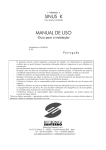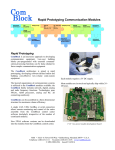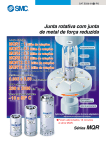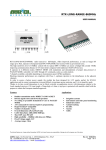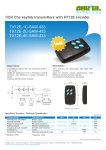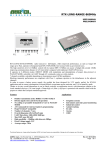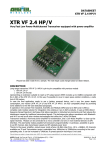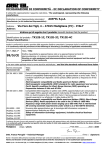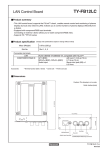Download User Manual
Transcript
RX CLASS1 869 --------------------------------------------------------------------------------------------------------------------------------------------------- User manual DESCRIPTION The RX-CLASS1 869 receiver has been designing to satisfy the stringent requirements of applications operating in Class 1 where radio communication may involve physical risks for the human person (as stated by European standards ETSI EN 300-220-2). These applications include social alarms, devices for help calls for people who live alone. They can operate in the VHF and UHF bands, on ranges reserved for Social Communications Alarms. In particular CLASS1 RX-869 operates in the band 869.2 to 869.25 MHz on 2 different channels with 25KHz narrowband and electrical features complying with the ETSI EN 300220-2 v2.3.1. (2010-02) in class 1. MECHANICAL DIMENSIONS AND PIN-OUT Pin-Out Applications 1) +Vcc 2) GND 3) RF Input (50 ohm) 7) GND 10) Power-Down 11) GND 12) Data-Rate 13) RSSI Out 14) Data Out 15) Radio channel selection Social alarms Nurse call Personal Security Smoke detector Electrical limits Voltage supply Input voltage Output voltage Operating temperature range -0,3V +6V -0,3V ÷ Vcc+0,3V 0V ÷ Vcc -10°C ÷ +55°C Technical features are subjected to change without notice. AUR°EL S.p.A doesn't assume any responsability for damages due improper use. --------------------------------------------------------------------------------------------------------------------------------------------------------------------AUREL S.p.A. Via Foro dei Tigli, 4 - 47015 Modigliana (FC) – ITALY 22/02/12 - Rev.B Page 1 of 9 Tel.: +39.0546.941124 Fax: +39.0546.941660 http://www.aurelwireless.com - email: [email protected] RX CLASS1 869 --------------------------------------------------------------------------------------------------------------------------------------------------- User manual CONNECTION PIN DESCRIPTION Pin 1 +V Connection to voltage supply: +3V ÷ +5,5V Pin 2 Ground Connection to GND Pin 3 Antenna Antenna connection, impedance 50 ohm. Pin 7 Ground Connection to GND Pin 10 Power Down Pin 11 Ground Digital input for the switching on of the receiver. Low logic level or pin not connected: receiver switches off (power-down mode) High logic level: receiver switches on (for details see paragraph “Power-down working”) Connection to GND Pin 12 Data-rate Pin 13 Pin 14 RSSI Out Data output Pin 15 Radio channel selection Data-rate digital input Low logic level: as input data-rate (range : 50 bps ÷ 2Kbps) High logic level: data-rate 1kbs. (For details see paragraph “Data-rate selection”) Analogue output for the measurement of the received radio signal level. Receiver digital data output. Digital input to set the radio channel Low logic level or pin not connected: reception of frequency 869,2325MHz High logic level: reception of frequency 869,2175MHz (for details see paragraph “Selection of radio channel”) HOW IT WORKS CLASS1 RX-869 integrates a new technology able to achieve high performance selectivity of the radio channel without using the traditional quartz filters so far implemented in the narrow-band super heterodyne receivers. The front-end circuit consists in a low noise amplifier with high gain, controlled by an automatic gain circuit with 50 dB dynamic and an high immunity mixer to the intermodulation. A fractional PLL circuit controls a high-performance low noise VCO which allows you to select two different radio frequencies through the pin 13: 869.2125 MHz (pin.13 open or GND) and 869.2375 MHz (pin.13 connected to Vs) . The FSK demodulator allows to choose two different data rate by PIN12: 1kbs (PIN12 to Vs) and transparent (open or GND pin 12). RX-869 integrates CLASS1 an u-controller that manages all radio circuits and power-down mode by PIN10. It’s available an analogue signal as RSSI to the 13 pin with voltage level proportional to the received radio signal. Technical features are subjected to change without notice. AUR°EL S.p.A doesn't assume any responsability for damages due improper use. --------------------------------------------------------------------------------------------------------------------------------------------------------------------AUREL S.p.A. Via Foro dei Tigli, 4 - 47015 Modigliana (FC) – ITALY 22/02/12 - Rev.B Page 2 of 9 Tel.: +39.0546.941124 Fax: +39.0546.941660 http://www.aurelwireless.com - email: [email protected] RX CLASS1 869 --------------------------------------------------------------------------------------------------------------------------------------------------- User manual Technical features Min Vs voltage supply Current supply RX = ON Pin 10 (pwdn) = 1 Pin 1 e 15 = +Vs Current supply in power-down mode Pin 10 (pwdn) = 0 Pin 1 e 15 = +Vs Center frequency reception Pin 15 = 0 o NC Center frequency reception Pin 15 = 1 RF sensibility FSK modulation e ∆F Bandwidth IF a –3dB Adjacent channel selectivity Receiver saturation on adjacent channel Blocking test ±2MHz Blocking test ± 10MHz Frequency image rejection Output square wave Setting: Pin 12 = 0 o not connected (Free mode) Output square wave Setting: Pin 12 = 1 (1kbps) RSSI analogue output (pin 13) RSSI output impedance (pin 13) Output low logic level (pin 14) Output high logic level (pin 14) Input high logic level (pin 10,12) Input low logic level (pin10,12) Spurious RF emission antenna Switching-on time Setting: (pin 1, 10, 15) = 0 → 1 Switching-on time PWRDN → RX-ON Usage: (pin 1, 15) Vcc = 1 (pin10) PWDN = 0 → 1 Operating temperature range Dimensions Typical 3 Max Unit 5,5 V 40 mA 3 -113 4 -2% MHz 869,2125 MHz -115 5 10 54 95 100 100 40 -117 6 dBm KHz KHz dB dB dB dB dB See See See See See 1 2 KHz See note 6 500 +2% Hz 3 V Kohm V V V V dBm 1 gnd+0,4 Vs-0,4 Vs-0,4 0,4 -60 -10 uA 869,2375 0 Notes note note note note note 1 1 3 3 2 See note 4 See note 4 100 ms See note 5 100 ms See note 5 +55 45,7 x 20 x 3,5 mm °C NOTE 1: Test carried out as shown in 8.3 paragraph of the normative ETSI EN 300 220-1 V2.3.1 NOTA 2: Test carried out as shown in 8.5 paragraph of the normative ETSI EN 300 220-1 V2.3.1 NOTA 3: Test carried out as shown in 8.4 paragraph of the normative ETSI EN 300 220-1 V2.3.1 NOTA 4: Values obtained with a maximum load of 10KΩ. NOTA5: Switching-on time means the time requested from the receiver to rich the technical features shown above. NOTA 6: This setting not allow to be under normative (note 1),it’s usefull for test. Technical features are subjected to change without notice. AUR°EL S.p.A doesn't assume any responsability for damages due improper use. --------------------------------------------------------------------------------------------------------------------------------------------------------------------AUREL S.p.A. Via Foro dei Tigli, 4 - 47015 Modigliana (FC) – ITALY 22/02/12 - Rev.B Page 3 of 9 Tel.: +39.0546.941124 Fax: +39.0546.941660 http://www.aurelwireless.com - email: [email protected] RX CLASS1 869 --------------------------------------------------------------------------------------------------------------------------------------------------- User manual Power-down function: RX-CLASS1 869 has a power down pin that allows a very fast switching off and switching on. POWER_DOWN mode: Setting to the low logic level Pin 10, the receiver is switches-off with 3uA of current consumption. Reception mode: Setting PWRDN pin 10 from low to high logic level the receiver switches on in 100ms, ready to receive as shown the technical features. Time diagram POWER-DOWN → RX Valid Reception Data Output Radio channel selection The RX-869 CLASS1 works in 869.2 MHz ÷ 869.25 MHz band assigned by ETSI for the exclusive use of applications on social alarms across Europe. EN 300 220-1 v2.3.1 normative also requires the use of 2 channels spaced 25 KHz. CLASS1 The RX-869 can operate on both frequencies using the pin 13 called "radio channel". Pin.15 logic value +Vs GND X Reception frequency (MHz) 869,2125 869,2375 869,2375 NOTE1: The change of the channel is achieved by power-down pin 10, setting from low logic level to high logic level. Technical features are subjected to change without notice. AUR°EL S.p.A doesn't assume any responsability for damages due improper use. --------------------------------------------------------------------------------------------------------------------------------------------------------------------AUREL S.p.A. Via Foro dei Tigli, 4 - 47015 Modigliana (FC) – ITALY 22/02/12 - Rev.B Page 4 of 9 Tel.: +39.0546.941124 Fax: +39.0546.941660 http://www.aurelwireless.com - email: [email protected] RX CLASS1 869 --------------------------------------------------------------------------------------------------------------------------------------------------- User manual During the normal reception mode the changing will be ignored. NOTE2: For different applications from “Social Alarm”, its’ possible modify the reception frequency channels. Data-rate selection pin.12 logic value +Vs GND X Data-rate values 1kbps 50-2000Hz range of free data rate output 50-2000Hz range of free data rate output The RX-869 CLASS1 internally uses a post-demodulator circuit that improves the performance in terms of sensitivity and adjacent channel rejection, this at the expense of less flexibility in the format of data that the receiver is able to handle. The 1Kbps data-rate uses a rebuilder of the output data with 1ms samplings, therefore the kind of data that the receiver can analyze must have a maximum time length of 1ms +-2%, for each single bit ( both lengths as low bit or high bit) . It’s possible to take frame time double, triple or quadruple time longer. he main advice is to realize a Manchester protocol with 2ms bit time length. The 1Kbps choice is not a bind, on demand it’s possible customize this parameter in the range of 0,5 kbps and 3 kbps. In order to figure out this matter, below is shown the timing diagram. In the opposite the “free modality” (open 12 pin) allows to receive each kind of data between 50Hz and 2KHz at the expense of the overcoming of the regulation. It is set in order to allow the evaluation test , as: test with an existing transmitter with a own protocol. In the final application, the use of the post-demodulator (pin 12 = + Vs) is bound to exceed the ETSI EN 300 220-1 v2.3.1 for class 1. NOTE: Setting of the data-rate value is achieved after the forcing of the power-down (Pin 10 from low to high). During normal operation, the control pin data rate will be ignored. Technical features of the output data with 1Kbps data-rate MANCHESTER Code Technical features are subjected to change without notice. AUR°EL S.p.A doesn't assume any responsability for damages due improper use. --------------------------------------------------------------------------------------------------------------------------------------------------------------------AUREL S.p.A. Via Foro dei Tigli, 4 - 47015 Modigliana (FC) – ITALY 22/02/12 - Rev.B Page 5 of 9 Tel.: +39.0546.941124 Fax: +39.0546.941660 http://www.aurelwireless.com - email: [email protected] RX CLASS1 869 --------------------------------------------------------------------------------------------------------------------------------------------------- User manual Temperature chart TBD Pin.13 “RSSI” diagram Pin.13 RSSI gives an analogue signal proportional to the received radio signal. The voltage range goes from 0 to 3 V maximum, 1K of output impedance and 90 dB of dynamic radio signal. It’s available with incoming radio signal with a time length higher of 1 second and updated each second. In picture number 1 it’s showed the RSSI output voltage diagram according to RF input power. The diagram is obtained applying to the RF input (pin3) of the receiver a RF generator modulated in FSK with 0,5 KHz square wave and with an index modulation of 3KHz. RSSI OUTPUT 3 2,5 ] V [ 2 l e v e L 1,5 I S S R 1 0,5 0 -115 -105 -95 -85 -75 -65 -55 -45 -35 -25 -15 Input Power[dBm] Picture 1: RF(dBm) input diagram according to the RSSI output(Volts) Technical features are subjected to change without notice. AUR°EL S.p.A doesn't assume any responsability for damages due improper use. --------------------------------------------------------------------------------------------------------------------------------------------------------------------AUREL S.p.A. Via Foro dei Tigli, 4 - 47015 Modigliana (FC) – ITALY 22/02/12 - Rev.B Page 6 of 9 Tel.: +39.0546.941124 Fax: +39.0546.941660 http://www.aurelwireless.com - email: [email protected] RX CLASS1 869 --------------------------------------------------------------------------------------------------------------------------------------------------- User manual Delta sensitivity [dB] 2 0 -2 -4 -20 0 20 40 60 Temperature [°C] Picture 1: Diagram of the delta sensitivity depending on temperature(°C) Center freq. Vs temp. TBD TEMPERATURE DIAGRAMS TBD Technical features are subjected to change without notice. AUR°EL S.p.A doesn't assume any responsability for damages due improper use. --------------------------------------------------------------------------------------------------------------------------------------------------------------------AUREL S.p.A. Via Foro dei Tigli, 4 - 47015 Modigliana (FC) – ITALY 22/02/12 - Rev.B Page 7 of 9 Tel.: +39.0546.941124 Fax: +39.0546.941660 http://www.aurelwireless.com - email: [email protected] RX CLASS1 869 --------------------------------------------------------------------------------------------------------------------------------------------------- Manuale d’uso Device usage In order to take advantage of the performances described in the technical features and to comply with the operating conditions which characterize the certification, the receiver has to be fitted up on a printed circuit, considering what follows: Voltage supply: 1. The receiver must be supplied by very low voltage security source protected against short circuits. 2. Maximum voltage variation admitted: ± 0.3 V. 3. De-coupling, next to the receiver, by means of a ceramic capacitor of minimum 100.000 pF value. Ground: It must surround in the better way the welding area of the receiver. The circuit must be achieved in double layer, with throughout vias to the ground planes, approximately each 15 mm. It must be properly dimensioned in the antenna connection area, in case a radiant whip antenna is fitted in(and area of approximately 50 mm is suggested). Fig.2 Lay-out advised for a correct working of the receiver 50 Ohm Line: 1. It must be as shorter as possible. 2. 1,8 mm wide for 1 mm thick FR4 printed circuits and 2,9 mm wide for 1,6 mm thick FR4 printed circuits. On the same side it must be kept 2mm away from the ground. 3. On the opposite side a ground circuit area must be present. Antenna connections: It may be utilized as the direct connection point for the radiating whip antenna. It is deeply suggested to put a 100nH inductance from pin 3 to ground in order to protect the device from the electrostatic discharges. It can bear the connection of the central wire of a 50 ohm coaxial cable. Be sure that the braid is welded to the ground in a close point. Antenna Technical features are subjected to change without notice. AUR°EL S.p.A doesn't assume any responsability for damages due improper use. --------------------------------------------------------------------------------------------------------------------------------------------------------------------AUREL S.p.A. Via Foro dei Tigli, 4 - 47015 Modigliana (FC) – ITALY 22/02/12 - Rev.B Page 8 of 9 Tel.: +39.0546.941124 Fax: +39.0546.941660 http://www.aurelwireless.com - email: [email protected] RX CLASS1 869 --------------------------------------------------------------------------------------------------------------------------------------------------- Manuale d’uso 1. A whip antenna, 80 mm long and approximately 1 mm dia, brass or copper wire made, must be connected to the RF input of the receiver. 2. The antenna body must be kept straight as much as possible and must be free from other circuits or metal parts (5cm minimum suggested distance). 3. It can be utilized both vertically or horizontally (the previous is highly suggested), providing that connection point between antenna and receiver input is surrounded by a good ground plane. N.B: As an alternative to the above mentioned antenna it is possible to use the whip model manufactured by Aurel (see related Datasheet and Application Notes). By fitting whips too different from the described ones, the EEC Certification is not assured. Other components: 1. Keep the receiver separate from all other components of the circuit (more than 5mm). 2. Keep particularly far away and shielded all microprocessors and their clock circuits. 3. Do not fit components around the 50 Ohm line. At least keep them at 5 mm distance. 4. If the antenna connection is directly used for a radiating whip connection, keep at least a 5 cm radius free area. In case of coaxial cable connection, 5 mm radius will suffice. REFERENCE NORMATIVE The RX CLASS1 869 is approved by CE and in particular satisfies the European normative ETSI EN 300 220-2 V2.3.1 in class 1 and EN 301 489-1 V1.4.1 in class 1. The product was tested in according with EN 60950 normative and it’s usable fitted in an isolated housing to ensure the above normative. The receiver must be supplied by very low voltage security source against the short circuits. Usage of receiver module is foreseen fitted in the housing which ensure the agreement of EN 61000-4-3 normative not directly applicable to the module itself. In particular, it’s at the user’s care the isolating of the extern antenna connection and antenna too, in fact the RF output of the receiver is not able to directly bear electrostatic charges foreseen in the above normative. Technical features are subjected to change without notice. AUR°EL S.p.A doesn't assume any responsability for damages due improper use. --------------------------------------------------------------------------------------------------------------------------------------------------------------------AUREL S.p.A. Via Foro dei Tigli, 4 - 47015 Modigliana (FC) – ITALY 22/02/12 - Rev.B Page 9 of 9 Tel.: +39.0546.941124 Fax: +39.0546.941660 http://www.aurelwireless.com - email: [email protected]









